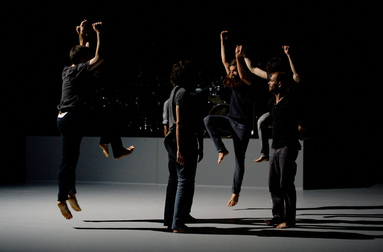 D'après une histoire vraie, photo de Marc Domage D'après une histoire vraie, photo de Marc Domage D’après une histoire vraie, by French choreographer Christian Rizzo, is two drummers and eight dancers, a total of ten men including five with long hair and half a dozen with beards. I’m saying this because it’s the casting of my wet dreams. I’m saying this because I should have loved it. I did like it though. The show certainly has a lot of qualities going for it, most of which come from the fact that it is inspired by folk dance. As a result, D’après… avoids a lot of contemporary dance clichés. First, let’s mention how rare it is for a choreographer to know how to make men dance together. Often, contemporary dance will go straight for antagonism – drama is always the easy answer – as though it is the only way men can interact. That’s right… Even in contemporary dance we have to put up with this macho bullshit. However, here we witness interactions that are refreshingly different. Men put their arms on each other’s shoulders, hold hands, support each other, lean on each other, and invite each other to dance. The feeling of fraternity, of inclusiveness that emerges as a result makes the show most endearing. Indeed, there is something soft about D’après…, like the middle grey floor where the dance takes place or the low-key lighting that gently reveals it. There is a balance between the moments when the dancers are physically linked and the ones when they dance on their own. Both appear to be grounding experiences. The performer finds his footing as he sways from foot to foot on the beat, holding his hands behind his back, before joining his comrades. Since folk dance is usually practiced by non-professionals, there is also a switch of importance between the limbs. Édouard Lock has said that the difference between a dancer and a non-dancer is in the legs. Here, it is obvious. The steps executed by the dancers are simple and it is in their arms that most of the movement occurs. There is no showing off. Gone is the ego of the performer. This is about the pleasure of being together. Also gone is the existential crisis from contemporary dance. Folk dance is life affirming. As one dancer walks around the grey floor, standing on the outside looking in, we can feel his admiration before these dancing bodies, his desire to join them. Where Rizzo has more trouble is in the tricky transition that a community dance must undergo to become a theatrical dance. The choreographer does what he can by introducing elements of contemporary dance, like the modern set design or the variations in numbers of performers and speed of the dance, yet there is something that prevents the dance from imposing itself in our eye or in our mind. Still, let’s mention that Rizzo does a better job of it than Hofesh Shechter had with Political Mother. In the end, the best thing about the show for me was the drummers. Then again I always feel that way. May 30 & 31 at 8pm Théâtre Jean-Duceppe www.fta.qc.ca 514.844.3822 / 514.842.2112 Tickets: 48-58$ / 30 years old and under: 43-48$
0 Comments
|
Sylvain Verstricht
has an MA in Film Studies and works in contemporary dance. His fiction has appeared in Headlight Anthology, Cactus Heart, and Birkensnake. s.verstricht [at] gmail [dot] com Categories
All
|
 RSS Feed
RSS Feed